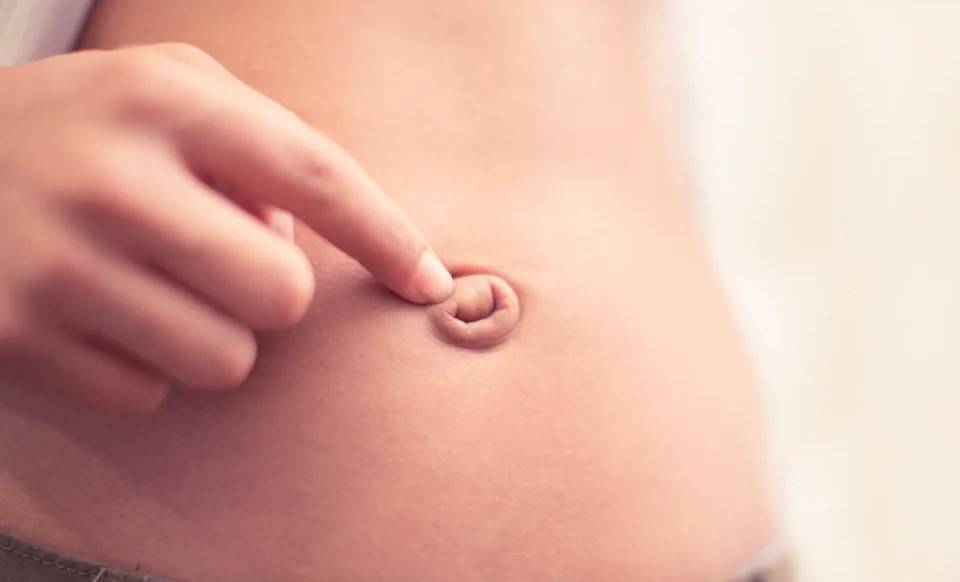You probably don’t think about your belly button much. Those weird little hollows aren’t exactly parts of our bodies we concern ourselves with much, but when you think about it, how much do you really know about your belly button?
Do you have an innie or an outie? Does it collect belly button fluff or lint? Maybe you’ve got a peculiar lump or bump, or perhaps you’re looking to insert essential oils into your navel to alleviate health concerns (no, really). Our belly buttons are actually a pretty big health factor – so, let’s dive in. Well, not into your belly button. You know what we mean.
What does your belly button say about your health?
Your belly button is just a scar
Our belly buttons are actually just scars. As soon as we are born, our umbilical cords get clamped and cut off. The remaining skin then shrivels up, turns black, dries up, and falls off – leaving your very first scar.
Dr Giuseppe Aragona, GP and Online Doctor for Prescription Doctor explains: “Your belly button, or navel as its otherwise known, is essentially the areas for which your umbilical cord was attached. The umbilical cord was the tube which carried nutrient’s from your mother to you.”
Most of us have innies
Most of us have innies – which basically means that our belly buttons point inwards. Some people though, have outies – where their belly buttons protrude inwards. Approximately 10% of the population have outies, making them about as common as those who are left-handed.
Dr Aragona says, “Every belly button is different, with different shapes, sizes and skin creases. The shape and dent of your navel essentially determines how the umbilical cord heals. Belly buttons don’t necessarily mean anything in particular about your health, however some people would argue that your belly button says a lot about you as a person.”
It’s teeming with bacteria
Belly buttons are low-key gross. Belly button fluff is a real thing, and guess what? It’s packed full of bacteria. This is because our navels have folds of skin and quite a few crevices (especially if you’ve got an innie). The folds and creases provide a nice warm, moist place for bacteria to grow.
Most of the time the bacteria remains at a low level, but sometimes it can become dense, which in turn causes an unpleasant smell.
This is why it’s important to keep your navel clean and dry. Always be sure to wash it properly when bathing or showering, and don’t forget to dry it properly so that it doesn’t stay moist (e.g. the ideal environment for bacteria to grow).
It’s actually an endogenous zone
Our belly buttons are packed full of nerve endings, which means this area might be ticklish or sensitive. A lot of people like making their belly buttons a focal point when getting intimate with their partner. After all they can be licked, dripped on, sucked on, and sipped on – providing pleasure for both parties, especially if somebody has a kink.
Dr Aragona says, “Yes, your belly button is an endogenous zone. Essentially it is just a scar however it can be sensitive due to its many nerve endings which means it may be sensitive, ticklish or even give you tingles.”
There are, apparently, health benefits to using oils in your navel
It has been claimed that putting different essential oils in and on the belly button can help with ailments like chapped lips, menstrual cramps, bloating, joint pain and more.
What essential oils do what?
- Lavender for relaxation and reducing stress
- Clove for dental problems
- Anise for antiseptic properties
- Black pepper for anti-inflammatory
- Cinnamon for anti-fungal
If you do decide to use essential oils on your skin, always dilute and thoroughly research before applying.
Although putting essential oils in your belly button has been claimed to do great things, Dr Aragona told us that there is no clinical advice that proves that doing so can aid health problems, “however of course there are those who will argue that it could help with the connection between spiritual and physical health. Much like other wellness practices, this could help improve mental symptoms but I am unsure as to whether it would benefits physical symptoms.”
How to look after your belly button
Dr Aragona advised that there is a chance that bacteria could infect a cyst or wound which is located on your belly button, and you may experience pain or swelling and pus that comes from your naval if there is an infection.
Delving into the topic Dr Aragona said, “Symptoms of a belly button infection are a redness or discolouration to the skin in the belly button, fever or chills, vomiting, itching or swelling around the affected area. Keeping your belly button clean is important, so when you shower ensuring you clean inside the naval and the skin around it.”
Your belly button can get a few different things wrong with it, some of which are:
Sebaceous Cyst (a liquid filled lump)
Umbilical Hernia (soft swelling near navel)
Bacterial Infection (crusty, itchy, leaking discharge)
Candidiasis (yeast infection)
Remember to contact your GP if you notice anything strange or funky with your belly button, or any other part of your body.

